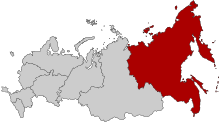Russian Far East

Russian Far East (Russian: Да́льний Восто́к Росси́и; pronounced [ˈdalʲnʲɪj vʌˈstok rʌˈsʲiɪ]) or Transbaikalia is a term that refers to the Russian part of the Far East, i.e., extreme east parts of Russia, between Lake Baikal in Central Siberia, and the Pacific Ocean. The Russian Far Eastern Federal District, which covers this area, should not be confused with the Siberian Federal District, which does not stretch all the way to the Pacific.
Terminology
In Russia
In Russia, the region is usually referred to as just "Far East", creating potential confusion with the international meaning of Far East in translation. The latter is usually referred to in Russia as "the Asia-Pacific Region" (Азиатско-тихоокеанский регион, abbreviated to АТР), or "East Asia" (Восточная Азия).
Geographic Features
History
Early history
Russia reached the Pacific coast in 1647 with the establishment of Okhotsk, and consolidated its control over the Russian Far East in the 19th century.
Territory
Until 2000, the Russian Far East lacked officially defined boundaries. A single term "Siberia and the Far East" (Сибирь и Дальний Восток) was often used to refer to Russia's regions east of the Urals without drawing a clear distinction between "Siberia" and "the Far East." Several entities with the name "Far East" had existed in the first half of the 20th century, all with rather different boundaries:
- 1920–1922: The Far-Eastern Republic (included Transbaikalia, Amur Oblast, Primorskaya Oblast, Sakhalin Oblast, and Kamchatka);
- 1922–1926: The Far-Eastern Oblast (included Pribaykalskaya, Amurskaya, Primorskaya, Sakhalinskaya, and Kamchatskaya guberniyas);
- 1926–1938: The Far-Eastern Krai (included modern Primorsky Krai and Khabarovsk Krai).
From 1938 to 2000, there was no official entity with this name and the term "Far East" was used loosely, much like "the West" in the United States.
In 2000, Russia's federal subjects were grouped into larger federal districts, and Far Eastern Federal District was created, comprising Amur Oblast, Chukotka Autonomous Okrug, Jewish Autonomous Oblast, Kamchatka Oblast, Koryak Autonomous Okrug, Khabarovsk Krai, Magadan Oblast, Primorsky Krai, Sakha (Yakutia) Republic, and Sakhalin Oblast. Since 2000, the term "Far East" has been increasingly used in Russia to refer to the district, though it is often also used more loosely.
Defined by the boundaries of the federal district, the Far East has an area of 6.2 million square kilometers—over one-third of the Russia's total area.
Demographics
Population
According to the 2002 Census, Far Eastern Federal District had a population of 6,692,865. Most of it is concentrated in the southern parts. Given the vast territory of the Russian Far East, 6.7 million people translates to slightly more than one person per square kilometer, making the Russian Far East one of the most sparsely populated areas in the world. The population of the Russian Far East has been rapidly declining since the dissolution of the Soviet Union (even more so than for Russia in general), dropping by 14% in the last fifteen years. The Russian government has been discussing a range of re-population programs to avoid the forecast drop to 4.5 million people by 2015, hoping to attract in particular the remaining Russian population of the near abroad.
Ethnic Russians and Ukrainians make up the majority of the population.
75% of the population is urban. The largest cities are (all population figures are as of the 2002 Census):
- Vladivostok (pop. 594,701)
- Khabarovsk (pop. 583,072)
- Komsomolsk-on-Amur (pop. 281,035)
- Blagoveshchensk (pop. 219,221)
- Yakutsk (pop. 210,642)
- Petropavlovsk-Kamchatsky (pop. 198,028)
- Yuzhno-Sakhalinsk (pop. 177,682)
- Nakhodka (pop. 177,133)
- Ussuriysk (pop. 157,759)
Traditional ethnic groups
The original population groups of the Russian Far East include (grouped by language group):
- Turkic: Sakha
- Eskimo-Aleut: Aleuts, Siberian Yupiks (Yuits)
- Chukotko-Kamchatkan: Chukchi, Koryaks, Alutors, Kereks, Itelmens
- Tungusic: Evenks, Evens, Nanais, Orochs, Ul'ch, Udegey, Orok
- Isolate: Yukaghirs, Nivkhs, Ainus
See also
References
External links
- Meeting of Frontiers: Siberia, Alaska, and the American West (includes materials on Russian Far East)
- Дальневосточный федеральный округ at WGEO
